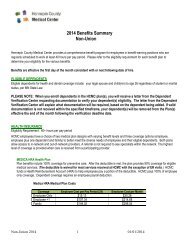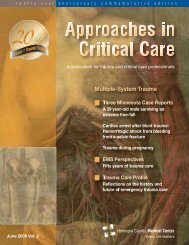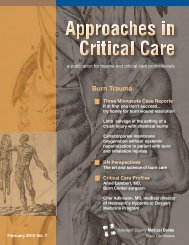Ischemic Stroke - Hennepin County Medical Center
Ischemic Stroke - Hennepin County Medical Center
Ischemic Stroke - Hennepin County Medical Center
Create successful ePaper yourself
Turn your PDF publications into a flip-book with our unique Google optimized e-Paper software.
Profiles in Critical Care<br />
Q and A withQ and A with<br />
Adnan Qureshi, MD<br />
“In terms of<br />
training,<br />
we now have<br />
one of the<br />
largest training<br />
programs<br />
in the<br />
United States<br />
in the<br />
subspecialties<br />
of stroke.”<br />
In his clinical practice, Adnan<br />
Qureshi, MD, has witnessed one of<br />
the most dramatic evolutions in modern<br />
medical care—the transformation<br />
of stroke treatment. As an international<br />
leader in stroke research and policy,<br />
he has helped fuel that transformation.<br />
Qureshi is a neurointerventionalist on<br />
the in-house stroke teams at<br />
<strong>Hennepin</strong> <strong>County</strong> <strong>Medical</strong> <strong>Center</strong> and<br />
the University of Minnesota <strong>Medical</strong><br />
<strong>Center</strong>, Fairview. He also is an internationally<br />
renowned speaker and<br />
author, Executive Director of the<br />
University-funded Minnesota <strong>Stroke</strong><br />
Initiative, associate head of the department<br />
of neurology at the University of<br />
Minnesota, and Executive Director of<br />
the U’s Zeenat Qureshi <strong>Stroke</strong><br />
Research <strong>Center</strong>. We interviewed<br />
Qureshi about his career path and<br />
the state of stroke care in Minnesota.<br />
What is a neurointerventionalist?<br />
How did you train for the specialty?<br />
A neurointerventionalist is a person<br />
who has training in both medical<br />
management of stroke and treating<br />
stroke with endovascular procedures<br />
like use of stents, specialized coils,<br />
and other mechanical treatments. I<br />
trained in neurology at Emory University<br />
in Atlanta and did a fellowship at Johns<br />
Hopkins, then another fellowship in<br />
endovascular surgery at Millard Fillmore<br />
Hospital in Buffalo, NY. So that’s the<br />
training background for neurointerventionalists–beyond<br />
neurology, I did<br />
specialty training in stroke, neurocritical<br />
care, and interventional procedures.<br />
What led you into that subspecialty?<br />
Many years ago, when I made the<br />
decision, it was clear this was the<br />
specialty that was going to evolve the<br />
most. When I first started in this specialty,<br />
there was only diagnosis—but<br />
not much for treatment. You could<br />
sense that treatment was coming. It<br />
would have been sad to miss out on<br />
something that was going to evolve<br />
so rapidly and positively, and there<br />
was an excitement of being part of<br />
something so dynamic. What has<br />
been fascinating and professionally<br />
satisfying is the amount of treatment<br />
we can do today, including reversing<br />
stroke. Reversing stroke was<br />
unheard of not that long ago, but<br />
today there are treatments that can<br />
restore blood and function to the brain.<br />
Why has stroke care evolved<br />
so rapidly?<br />
When there’s no treatment, people<br />
are likely to move faster. Also, the<br />
evolution of cardiology and trauma<br />
care has helped stroke care. Cardiology,<br />
including the use of stents, angioplasty,<br />
etc., has evolved in a similar way<br />
to stroke care but over a longer period<br />
of time. That’s allowed us to evaluate<br />
new treatments and put them<br />
into practice more quickly. Trauma<br />
developed a system to take people<br />
from the field and bring them to specialized<br />
hospitals as quickly as possible.<br />
Those lessons are being applied<br />
to stroke care.<br />
Approaches in Critical Care | December 2008 | 11
















